45 Math Brain Teasers for Kids
Improve problem-solving skills with these fun brain teasers

Author
Jill Padfield
Published:
March 2025
Key takeaways
- Math brain teasers improve life skills – Consistently doing brain teasers has been shown to improve academic focus, critical thinking, and confidence.
- Start with easy brain teasers – First introduce simple problems, and then work up to more complex problems once your kids have grasped the basics.
- Brain teasers encourage a love of learning – Brain teasers are a lot like games, which makes them fun for young children and adults alike.
Have you ever heard your kids say any of the following? :
- Math is boring.
- Math is too difficult, I don’t get it!
- I don’t like math.
Though this reaction is fairly common, there is a solution! Math brain teasers encourage out-of-the-box thinking in a fun and engaging way. They often require logical thinking rather than needing a child to be a math expert. So, many kids don’t even realize they’re learning.
Math brain teasers are a great way to relax students at the beginning of a class and to inspire a love of learning at home.
45 Fun, engaging brain teasers for kids
Now, let’s dive into some of the different brain teasers you can try out with your children:
Click each question to reveal the answer.
1. There are seven apples and you take away three of them. How many apples do you have?
Answer: Three — because that’s how many apples you took.
2. When does 9 + 5 = 2?
Answer: When we think in terms of time — 9 a.m. + 5 hours = 2 p.m.
3. People can feel me but never touch me. I can fly your kite or sail your ship. What am I?
Answer: The wind.
4. A merchant can fit 10 large boxes or 8 small boxes into a container for shipping. In one shipment, he sent 96 boxes. If there were more large boxes than small boxes, how many full containers did he ship?
Answer: 11 containers.
- 7 containers with large boxes → 7 × 8 = 56 boxes
- 4 containers with small boxes → 4 × 10 = 40 boxes
Total: 96 boxes in 11 containers.
5. Multiply this number with any other number and you will always get the same answer. What’s the number?
Answer: Zero.
6. How many sides does a circle have?
Answer: Two — the inside and the outside.
Table of contents
Access more math practice with DreamBox
Turn math into playtime with DreamBox Math
DREAMBOX MATH
Get started for FREE today!
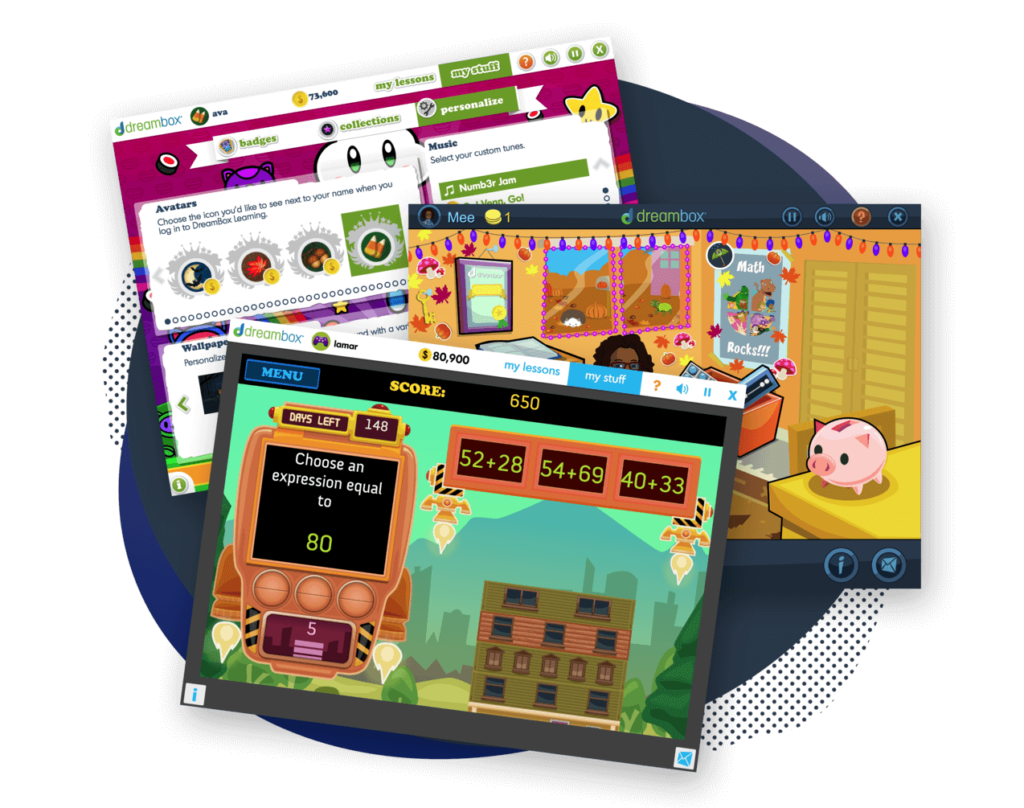
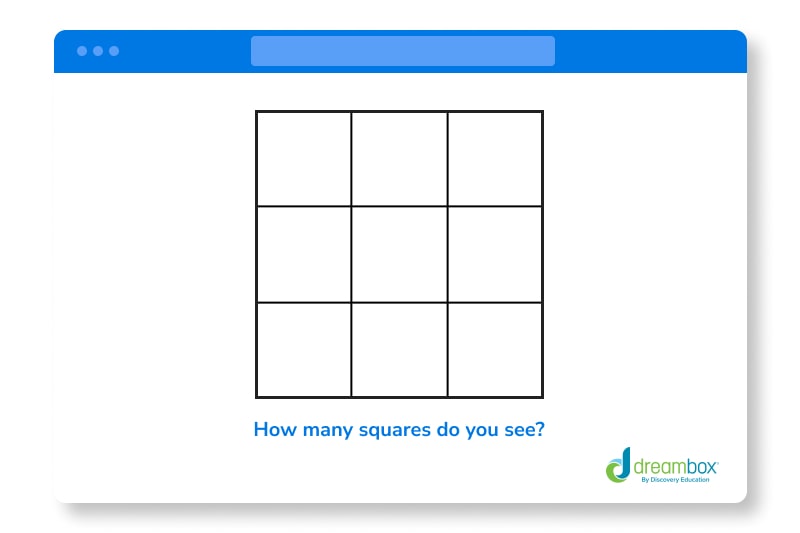
7. How many squares do you see in the image above? (Hint: It’s not nine!)
Answer: There are more than nine squares! To find the correct number, count all the individual small squares, plus all the larger squares formed by combining smaller ones. For a classic 3×3 grid, the total number of squares is 14.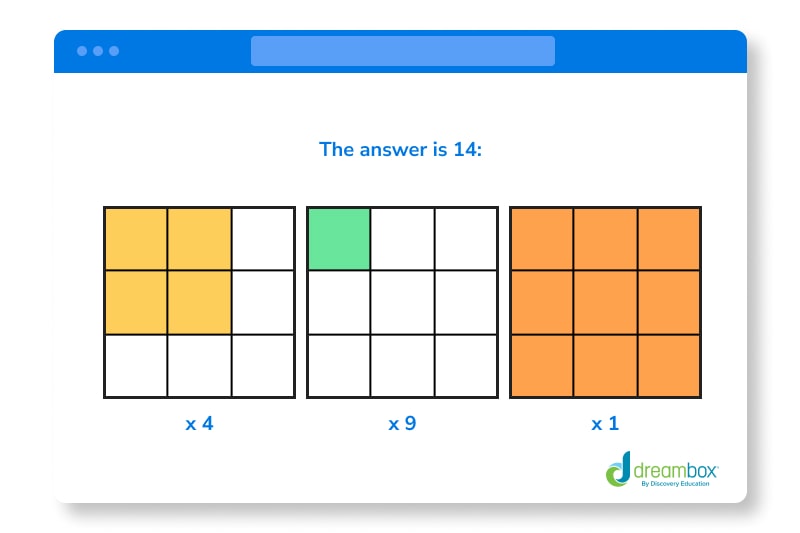
8. One grandmother, two mothers, and two daughters went on a trip to the zoo together and bought one ticket each. How many tickets did they buy?
Answer: Three. The grandmother is also a mother, and the mother is also a daughter. So there were only three people.9. What is the maximum number of times you can subtract five from 25?
Answer: Once. After you subtract five from 25, it becomes 20. From that point on, you are no longer subtracting from 25.10. If you toss a coin 50 times and it always lands on heads. What is the chance that it will land on heads with your next throw?
Answer: 50/50. There are two sides to a coin, so every throw has a 50% chance of landing on heads. Previous throws do not affect the next throw.11. I appear twice in the morning and twice in the evening. But I only appear once at night. What am I?
Answer: The letter N.12. The river crossing problem: A farmer is traveling with a fox, a goose, and a sack of beans. He comes across a river with a boat, but he can only take one item at a time. If he leaves the goose with the fox, the fox will eat it. If he leaves the goose with the beans, the goose will eat them. How does he get everyone across safely?
Answer: Here’s the step-by-step solution:- The farmer brings the goose across the river first.
- The farmer then brings the fox across and takes the goose back with him.
- He then takes the beans across, leaving the goose alone.
- The fox and the beans are now on the other side of the river.
- He goes back for the goose and brings it to the other side.
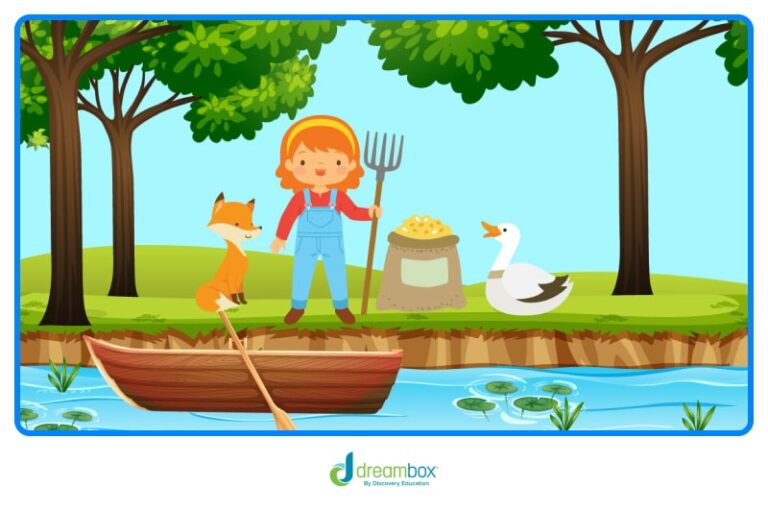
13. Using only addition, how can you get to 1000 by using only 8’s?
Answer: 888 + 88 + 8 + 8 + 8 = 1000. The trick to this riddle is to find the closest number to 1000 using only 8s (888). From there, it’s easier to work out the rest.
14. Which glass contains the most water?
Answer: The glass with the paperclip inside. All of the glasses look like they have the same amount of water, but this doesn’t take into account the weight of the objects inside the glasses. If you remove the larger objects, the water will go down more than if you remove smaller objects. We don’t know the exact size of each item, but the paperclip is definitely the smallest.
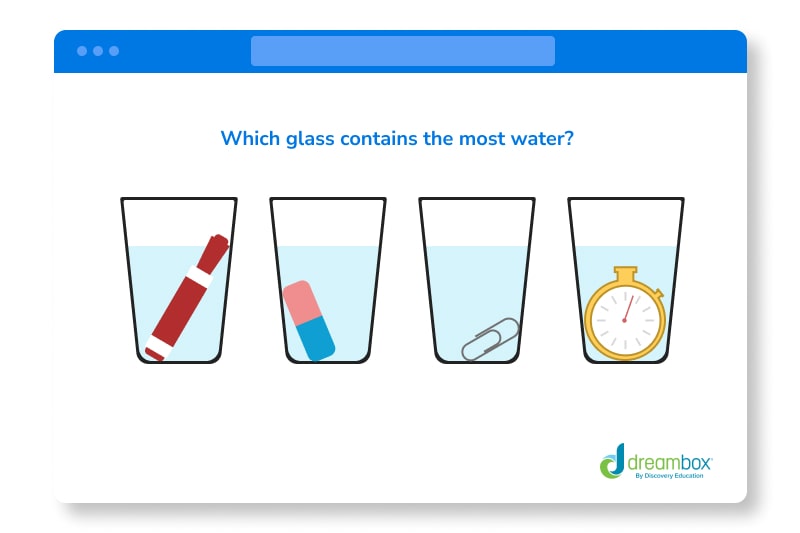
15. What is the value of a yellow triangle? Solve this equation by working out the value of each shape.
Answer:
- The first equation has three red circles: 12 ÷ 3 = 4. This means each red circle has a value of 4.
- We now know the red circle is 4. In the second equation, the diamond must have a value of 2 because 6 – 4 = 2.
- In the third equation, the diamond represents 2. Therefore, 12 – 2 = 10.
- Since there are two triangles, divide 10 by 2 to get 5. Each triangle has a value of 5.
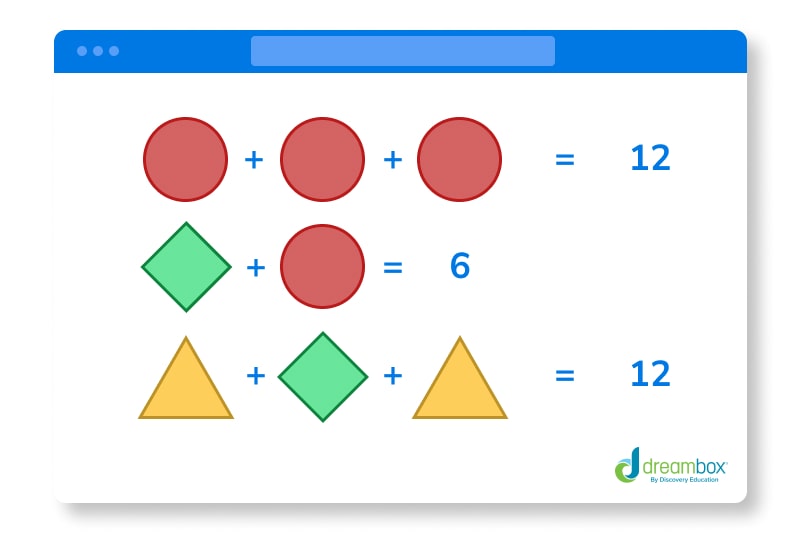
16. Which single digit appears most frequently between (and including) numbers 1–1000?
Answer: The digit 1 appears the most frequently.
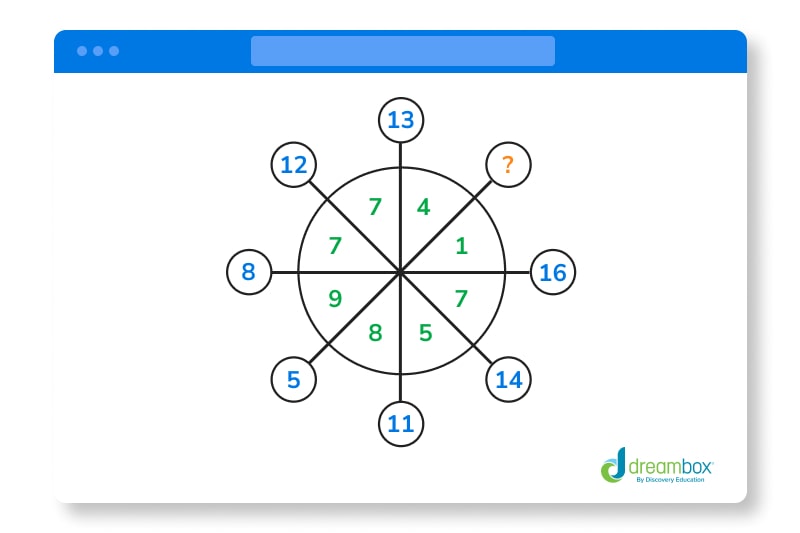
17. Work out the answer that should replace the ? in this diagram above.
Hint: This math brain teaser uses addition.
Answer: The answer is 17 because each circle is the total of the two digits in the opposite quadrants.
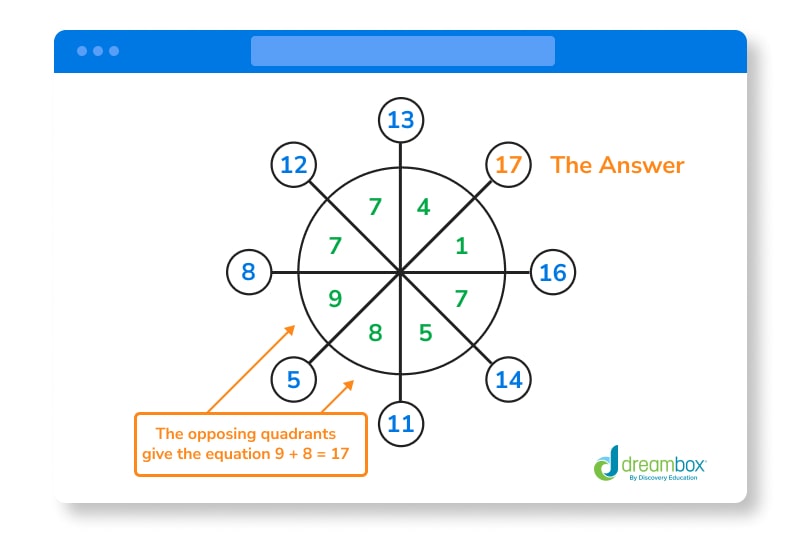
18. Mr. Blue lives in the blue house. Mrs. Pink lives in the pink house and Mr. Purple lives in the purple house. So, who lives in the white house?
Answer: The president. This is a bit of a tricky riddle because you might think it’s Mr. White.
19. Your sock drawer contains 26 white socks and 30 black socks. The light is off so you can’t see the color of the socks. How many socks do you need to grab to ensure you have a matching pair?
Answer: Three. In the worst-case scenario, you pick one black sock and one white sock. The third sock you pick will match one of them.
20. Which weighs more, 16 ounces of feathers or a pound of solid gold?
Answer: They weigh the same because 16 ounces equals one pound.
21. What 5-letter word becomes shorter when you add two letters to it?
Answer: Short. When you add the letters “e” and “r,” the word becomes “shorter.”
22. I am as light as a feather but even the world’s strongest man can’t hold me for more than 5 minutes. What am I?
Answer: Breath. No one can hold their breath for longer than a few minutes, not even the strongest person.
23. The butcher is 5ft 11 inches tall and he has size 9 feet. What does he weigh?
Answer: Meat, because he works in a butcher shop.
24. A hotel has eight floors. Four people live on the ground floor, and each floor has two more people living on it than the previous level. Which floor calls the elevator the most?
Answer: The ground floor. Everyone living on the other floors still needs to call the elevator there to get to their own floors.
25. You are a bus driver on your daily route. At the first stop, five people get on and no one gets off. You drive eight miles until you get to the second stop where four people get on and three get off. After another ten miles, you reach the third stop where six people get on and five get off. What color are the bus driver’s eyes?
Answer: You are the bus driver, so the bus driver’s eyes are the color of your own eyes.
26. There is 900 ml of water in a jug and each cup can only hold 100 ml. How many cups would you need to pour out all the water equally, filling only 75% of each cup?
Answer: 12 cups. 75% of 100 ml is 75 ml. Divide 900 ÷ 75 = 12.
27. Divide 30 by ½ and then add 5, what’s the answer?
Answer: 65. Dividing by ½ is the same as multiplying by 2: 30 × 2 = 60. Then add 5 → 65.
28. There is a clothing store where the owner has come up with his own method of pricing his items. A tie costs $15, a shirt costs $25, a skirt costs $25, and trousers cost $40. Using this method, how much would a coat cost?
Answer: $20. The method is adding $5 for each letter in the name of the item. “Coat” has four letters → 4 × 5 = 20.
29. What can you put between a 6 and a 7 to make the result greater than 6 but less than 7?
Answer: A decimal point. 6.7 is greater than 6 but less than 7.
30. What number should go in the space where the car is parked?
Answer: 87. Turn the image upside down and the parking lot numbers run in sequence: 86, 87, 88, 89, 90, 91.
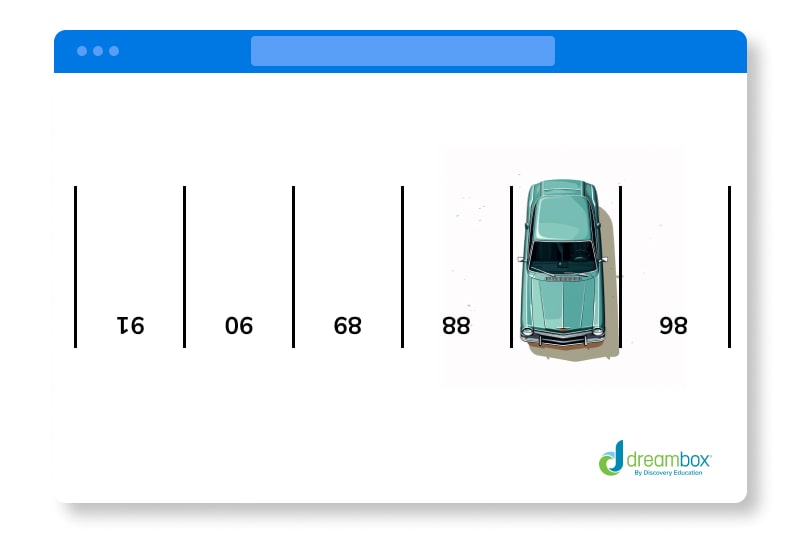
31. A farmer explains the animals he keeps on his farm to a neighbor. He says “I only keep sheep, goats, and horses. At the minute, I have all sheep except three, all goats bar four, and all horses bar five.” How many does he have of each animal?
Answer: Three sheep, two goats, and one horse. Equations:
- Goats + horses = 3
- Horses + sheep = 4
- Sheep + goats = 5
32. Mr. Bower has four daughters and each of those daughters has one brother. How many children does Mr. Bower have?
Answer: Five children. The daughters all share the same brother.
33. Mrs. Howell died at a very old age. But she only had 26 birthdays. How is this possible?
Answer: She was born on February 29th in a leap year, which occurs every four years.
34. How do you write 23 by only using the number 2?
Answer: 22 + (2 ÷ 2) = 23. First, 2 ÷ 2 = 1, then 22 + 1 = 23.
35. Can you create a true math equation using only the numbers 2, 3, 4, and 5 and the symbols + and =?
Answer: 2 + 5 = 3 + 4. Both sides equal 7.
36. Two mothers and two daughters each had one egg for breakfast, but they only ate three eggs in total. How is this possible?
Answer: There are only three people: a grandmother (also a mother), a mother (also a daughter), and a daughter.
37. I am a three-digit number. My first digit is three less than my second digit. My second digit is four times greater than my third digit. What number am I?
Answer: There are two possible answers: 141 and 582. Explanation: – 141 → 1 is 3 less than 4, 4 is four times 1. – 582 → 5 is 3 less than 8, 8 is four times 2.
38. Amy planted sunflower seeds in her back garden. Every day, the number of flowers doubles. If it takes 56 days for the flowers to fill the whole garden, how long would it take for the flowers to fill half the garden?
Answer: 55 days. If the flowers double each day, half the garden is filled the day before it’s full.
39. Solve this pattern equation. If: 2+2 = 44, 3+3 = 96, 4+4 = 168, 5+5 = 2510. Then what is 6+6?
Answer: 3612. The pattern is: the number multiplied by itself (6×6=36) followed by the number added to itself (6+6=12).
40. A farmer has 23 sheep in his field. One day, a massive storm hits and all but eight of his sheep ran away. How many sheep does he have left?
Answer: Eight sheep, because the rest ran away.
41. Aidan works at an aquarium. When he tries to put each turtle into a separate tank, he has one turtle too many. When he tries to put two turtles into each tank, he has one tank too many. How many turtles and tanks does Aidan have?
Answer: Four turtles and three tanks. – One turtle per tank → 1 extra turtle. – Two turtles per tank → 1 extra tank.
42. This shape looks like a door and a chocolate bar. It has four sides with two sets of equal opposites. What is the shape?
Answer: Rectangle. It has two sets of equal opposite sides.
43. Freddie was given the task of painting number plates for 100 apartments. How many times did he have to paint the number 8?
Answer: 20 times. Numbers containing 8: 8,18,28,38,48,58,68,78,80,81,82,83,84,85,86,87,88(2),89,98.
44. If two is company and three is a crowd, what are four and five?
Answer: Nine. Simply add four and five together.
45. This one-digit number is less than nine and more than two. It is also one more than the number of sides on a hexagon. What’s the number?
Answer: Seven, because a hexagon has six sides.
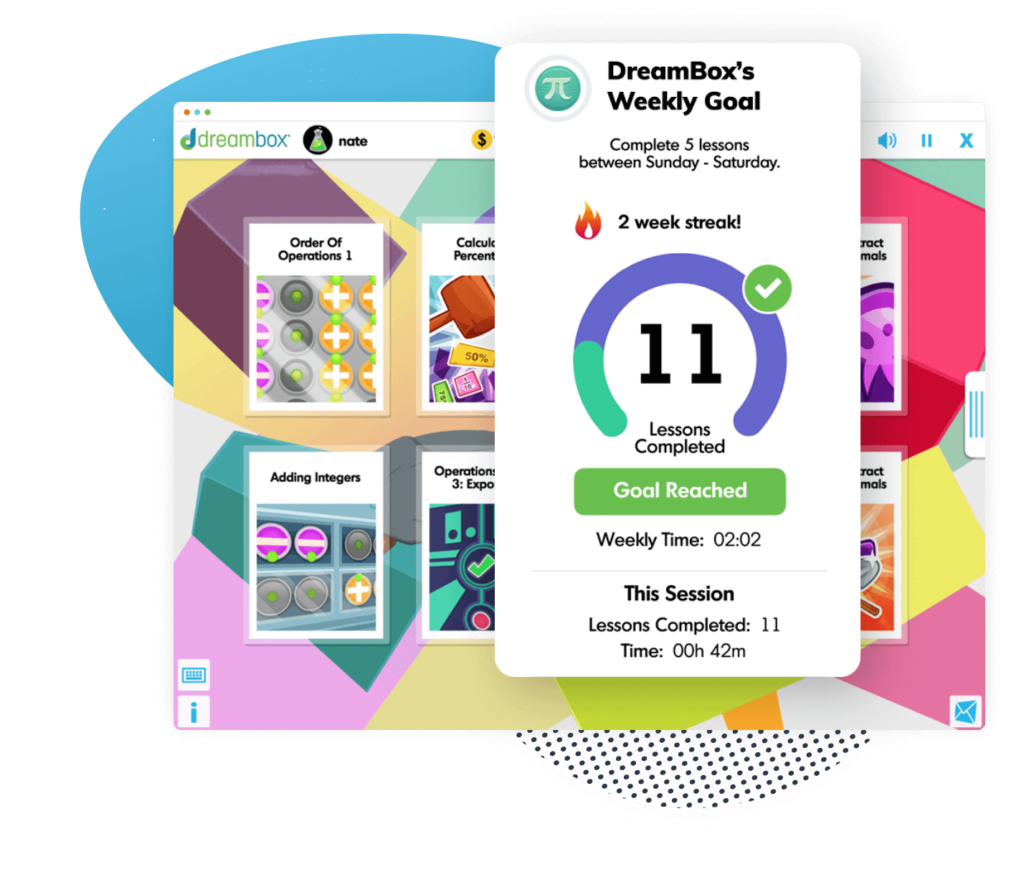
The math program that drives results
Get started today!
DreamBox adapts to your child’s level and learning needs, ensuring they are appropriately challenged and get confidence-building wins.
FAQs about brain teasers for kids
Brain teasers help children to develop a range of important life skills including problem-solving, critical thinking, and memory retention. Fun brain teasers also encourage children to persist with a problem and increase confidence.
Brain teasers require children to look at a problem from all angles and consider an alternative perspective. By regularly practicing brain teasers, children learn how to analyze small details and use logic to solve an issue they’re facing.
Brain teasers have many benefits for children. However, it’s important to start slow to prevent your child from getting frustrated. Once your child has mastered the basics, then they can move on to more complicated brain teasers.
Brain teasers are a great way for children to develop essential life skills that will improve academic performance as well as persistence and dedication. Moreover, brain teasers are beneficial for people of all ages, including college-age students and adults, since they improve memory and encourage critical thinking.
Take at home math practice to the next level
Empowering parents and educators to make math practice more impactful. Plus, your kids will love it.
